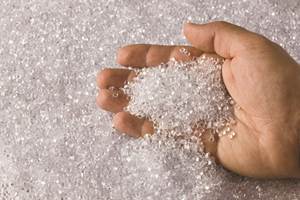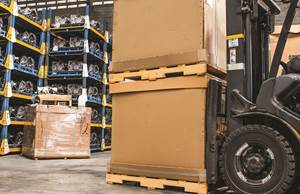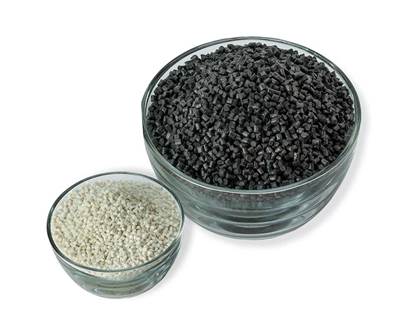Polymer Science for Those Who Work With Plastics: Why Entanglements — Not Just Molecular Weight — Drive Plastic Performance
Ever try running your fingers through tangled hair? Yeah … that’s not fun, but that’s what happens at the molecular level when polymer chains reach the right length. They wrap around each other, intertwine and … get stuck — and those tangles are the real reason plastics perform the way they do.
This is the third article in my series about applying polymer science to plastic materials (read about repeating units and molecular weight). Last time, we looked at molecular weight: what it is; how it’s calculated and why it matters. It’s a simple concept on paper: just add up the atomic weights in a polymer chain, and you’ve got its molecular weight.
In reality though, while that number is tiny by everyday standards, it’s huge at the molecular scale. Polymers are “giant molecules,” after all. And they don’t come as single chains, either. They’re made as a distribution — some short, some long, with most in between.
When polymer chains get long enough, something important happens — they start to tangle.
So far, so good. But to really understand what changes as molecular weight increases, we need to go one layer deeper than just understanding the molecular weight, and that’s where the idea of entanglement comes in.
What Really Happens When Molecular Weight Increases?
Let’s step back and consider this: Increasing molecular weight increases the length of the polymer chain, and it’s that increased chain length — not just the weight — that causes the real shift in polymer properties.
When polymer chains get long enough, something important happens — they start to tangle. This phenomenon, known as entanglement, refers to the physical interlacing of long chains with one another, much like fishing line or long hair gets knotted together (see Figure 1). These are not chemical bonds, but physical interactions that significantly restrict chain movement. Once entangled, the chains are difficult to pull apart, and the material undergoes a dramatic transformation in both its molten and solid states. Entanglement gives rise to strength, elasticity and viscosity — key performance traits driven by these molecular-level constraints.
FIG 1 — Illustration of polymer entanglement. Source: Plastics Technology
Haircuts and Tangled Chains
Let’s take a step back to consider the idea of tangled hair. Imagine the difference between a buzz cut and long hair. A person with a buzz cut doesn’t worry about tangles, right? But someone with long hair — say, down to the mid-back — absolutely does. The longer the hair, the more it is prone to tangle. People with long hair spend time brushing and conditioning it to prevent those painful, damaging knots.
The idea is that when polymers are short (low molecular weight), they don’t entangle. But as chain length increases, there’s a tipping point where entanglements become unavoidable. That tipping point is what polymer scientists call the critical entanglement molecular weight (Mc). Polymers undergo a kind of metamorphosis at this point — like a caterpillar turning into a butterfly. Before entanglement, the polymer is free-flowing and easier to process. After entanglement, it’s dramatically different — it’s stronger, tougher and harder to melt, flow and deform. A good way to visualize this is by plotting viscosity versus increasing molecular weight, as seen in Figure 2. Notice how the curve steepens at a particular molecular weight — that’s the point of critical entanglement.
FIG 2 — Molecular weight vs. zero-shear viscosity, highlighting the point at which molecular weight is high enough for entanglements to begin.
Real-World Examples of Entanglement in Action
At low molecular weights — below the critical entanglement threshold — polypropylene (PP) does not have the mechanical strength it needs for structural integrity. It behaves more like a soft, waxy material with poor mechanical strength and limited use in structural applications. As the molecular weight increases and passes the entanglement threshold, PP transitions into what we typically think of as a thermoplastic. It gains toughness, impact strength and ductility, making it suitable for fibers, automotive trim and rigid packaging.
For each application, the molecular weight of the polymer is carefully tuned to achieve the right balance of strength and processability. Caution: Too much of a good thing will spoil it, as increasing molecular weight too high makes it more and more difficult to process, as seen in Figure 2 where viscosity steadily increases with molecular weight.
Polyethylene: HDPE vs. LDPE
Polyethylene (PE) offers another useful illustration of the entanglement effect. Both high-density polyethylene (HDPE) and low-density polyethylene (LDPE) are made from the same repeat unit, but their molecular structures differ significantly, see Figure 3.
HDPE is made of relatively linear polymer chains — long, straight molecules with few branches. These chains pack tightly, crystallize easily and create a stiff, dense material. LDPE, on the other hand, has many side branches extending off the main chain. These branches are often hundreds of carbon atoms long — long enough to behave like polymer chains themselves.

FIG 3 — Molecular diagrams of HDPE and LDPE, illustrating the difference in branching and entanglement.
And what do those LDPE branches do? They entangle and far more than the linear chains in HDPE. These long side branches create a tangled network within the melt, increasing the number of entanglements. That network gives LDPE greater elasticity, helping it resist sagging and necking during processing. This is why LDPE has significantly higher melt strength than HDPE.
As the material cools, the same entangled network interferes with the polymer chain’s ability to align and crystallize. The tangled chains can’t easily disentangle, which increases the amorphous content; and because the amorphous phase is what gives a plastic its flexibility, LDPE ends up much softer and more pliable than HDPE.
Final Thought: It’s Not Just the Weight — It’s the Tangle
The key idea here is that molecular weight matters because of what it causes: entanglement. Once chains are long enough to entangle, the polymer’s behavior changes dramatically. Toughness, viscosity, elasticity and even thermal properties are all influenced by this molecular-level phenomenon.
The key idea here is that molecular weight matters because of what it causes: entanglement.
But there’s a trade-off. If you increase molecular weight too much, the material becomes difficult to process. That’s why molecular weight must be carefully tuned for each application — to strike the right balance between mechanical performance and processability.
So the next time you’re troubleshooting a plastic material or selecting a resin for a specific application, don’t just ask about molecular weight. Consider how entanglements influence the properties you care about.
About the author: David Rhoades is a lecturer in polymer science and plastics engineering at Penn State Behrend. With a doctorate in polymer science and engineering from the University of Southern Mississippi, he helps students connect classroom learning with real-world applications in the plastics industry. Rhoades also consults and guest lectures, using his knowledge to solve practical challenges in plastics engineering. Contact: 814-898-6153; dwr131@psu.edu.
Related Content
The Fundamentals of Polyethylene – Part 1: The Basics
You would think we’d know all there is to know about a material that was commercialized 80 years ago. Not so for polyethylene. Let’s start by brushing up on the basics.
Read MoreFundamentals of Polyethylene – Part 3: Field Failures
Polyethylene parts can fail when an inappropriate density is selected. Let’s look at some examples and examine what happened and why.
Read MorePolymer Showdown — PC/ABS vs. PC/PBT — May the Best Material Win
First in a series, experts from plastics engineering consultancy The Madison Group will pit leading thermoplastics against each other to see how they differ in processing characteristics, chemical resistance, thermal and mechanical performance, and more.
Read MoreThe Fantasy and Reality of Raw Material Shelf Life: Part 1
Is a two-year-old hygroscopic resin kept in its original packaging still useful? Let’s try to answer that question and clear up some misconceptions.
Read MoreRead Next
Polymer Science for Those Who Work With Plastics: Molecular Weight — What It Is and Why It Matters
Molecular weight might seem like an abstract concept, but it plays a crucial role in determining the behavior of plastics during processing and in their final applications.
Read MoreWhat You Need to Know About Drying Specialty Nylons
PPA is being used more frequently by molders for demanding high-heat applications in automotive and other markets. While in the nylon family, it does not dry quite like nylon. Follow these tips.
Read MorePolymer Science for Those Who Work With Plastic — Part 1: The Repeat Unit
What are the basic building blocks of plastics and how do they affect the processing of that material and its potential applications in the real world? Meet the repeat unit.
Read More











